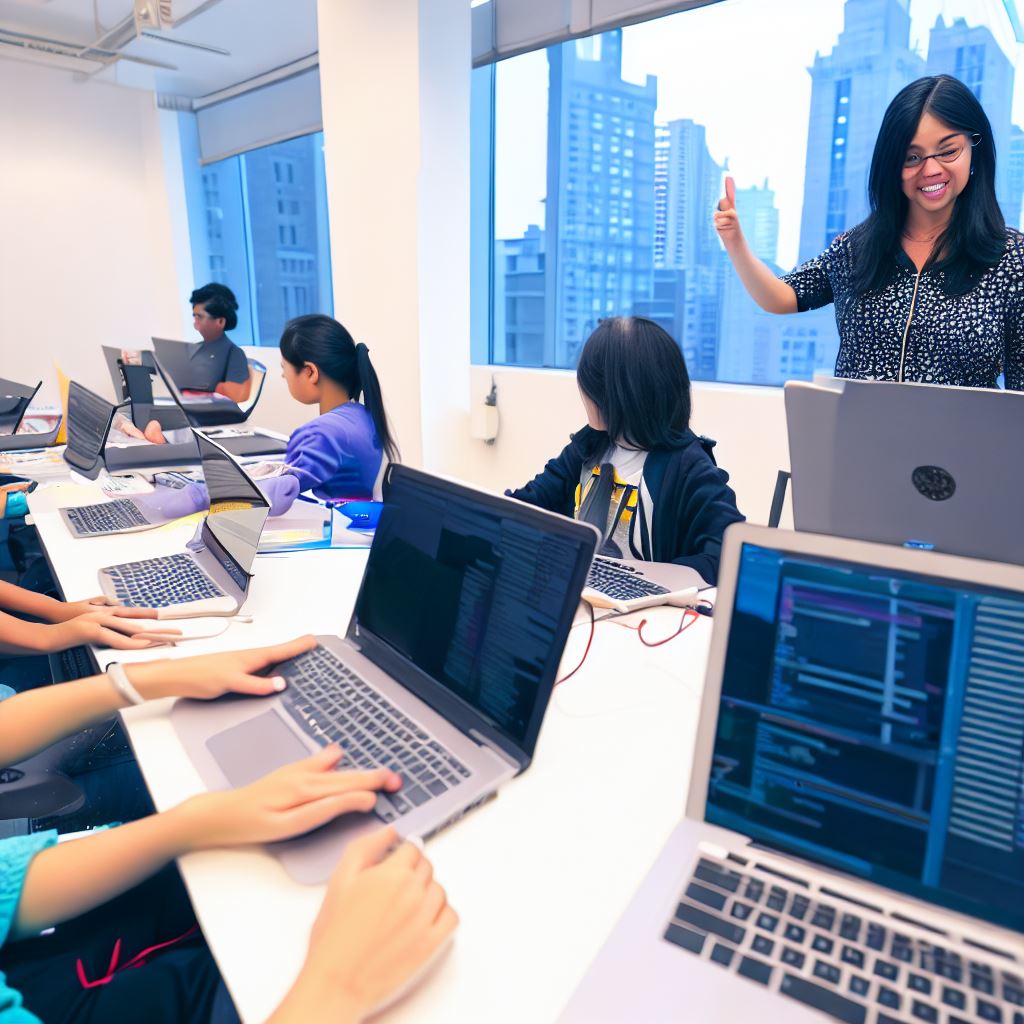Introduction
Learning coding skills is becoming increasingly important for kids in today’s digital world.
It goes beyond just being able to navigate technology; coding develops essential skills such as problem-solving and logical thinking.
Introducing the concept of learning through failure can greatly enhance a child’s coding education.
It encourages kids to step out of their comfort zones and embrace mistakes as valuable learning opportunities.
By adopting a mindset that failure is not something to be shunned, but rather a stepping stone towards success, kids become resilient and more willing to take risks in their coding endeavors.
This approach allows them to learn from their mistakes and iterate upon their solutions, ultimately leading to better outcomes.
By allowing kids to explore coding in a safe and supportive environment, they develop not only coding skills but also key life skills like perseverance and critical thinking.
They understand that coding is not about getting it right on the first try, but rather a continuous learning process.
Learning through failure also fosters creativity, as kids are encouraged to think outside the box and explore different approaches.
It helps them develop a growth mindset, where challenges are seen as opportunities for growth rather than obstacles to overcome.
Basically, learning through failure is a valuable approach to coding education for kids. It builds resilience, fosters creativity, and teaches important life skills.
By embracing mistakes and seeing them as learning opportunities, kids become better equipped to succeed in the ever-evolving digital landscape.
Read: Using CodingBat as a Supplement to Online Courses
Benefits of Learning Through Failure
1. Encourages problem-solving skills
- When kids are allowed to fail and make mistakes while coding, it forces them to think critically and find solutions.
- They learn to analyze problems, identify errors, and come up with different approaches to solve them.
- This builds their problem-solving skills and helps them become better coders in the long run.
2. Teaches perseverance and resilience
- Failure is a part of the learning process, and coding is no exception.
- By experiencing failures, kids learn to persevere and not give up easily.
- They understand that setbacks are temporary and can be overcome through hard work and determination.
- Coding teaches them to bounce back from failure and keep trying until they achieve success.
3. Fosters creativity and innovation
- Failure encourages kids to think out of the box and find creative solutions.
- When their initial approach fails, they are forced to come up with innovative ideas.
- This fosters their creativity and helps them explore different possibilities and alternatives.
- Through coding, kids learn to see failure as an opportunity to think creatively and push boundaries.
4. Promotes a growth mindset
- Learning through failure teaches kids to embrace challenges and view them as opportunities for growth.
- They understand that failure is not a reflection of their abilities but a chance to learn and improve.
- This mindset promotes a love for continuous learning and a desire to constantly improve their coding skills.
- Kids with a growth mindset are more likely to take risks, try new things, and achieve greater success in coding and beyond.
In essence, learning through failure in coding has numerous benefits for kids. It encourages problem-solving skills, teaches perseverance and resilience, fosters creativity and innovation, and promotes a growth mindset.
By allowing kids to fail and make mistakes, we equip them with important skills and attitudes that will benefit them not just in coding, but in all areas of life.
Tech Consulting Tailored to Your Coding Journey
Get expert guidance in coding with a personalized consultation. Receive unique, actionable insights delivered in 1-3 business days.
Get StartedRead: Python’s Role in Data Science: Dive into Analysis!
How to Embrace Failure in Coding Education
1. Create a safe and supportive learning environment
- Establish a classroom culture where students feel comfortable making mistakes.
- Encourage open communication and collaboration among students.
- Promote a growth mindset by emphasizing the importance of learning and improvement.
- Provide resources and support to help students overcome challenges and obstacles.
- Build trust by showing empathy and understanding when students make mistakes.
2. Set expectations and normalize mistakes
- Make it clear from the beginning that mistakes are an integral part of the coding learning process.
- Set realistic expectations and communicate that perfection is not the goal.
- Showcase examples of successful people who have faced failures and bounced back.
- Encourage students to share their failures and mistakes as learning opportunities.
- Remind students that even experienced coders make mistakes and learn from them.
3. Encourage experimentation and risk-taking
- Provide opportunities for students to explore different coding concepts and techniques.
- Encourage students to step out of their comfort zones and try new approaches.
- Highlight the benefits of taking risks and learning from the outcomes.
- Promote creativity by allowing students to think outside the box and find innovative solutions.
- Celebrate the process of experimentation, regardless of the outcome.
4. Provide constructive feedback and guidance
- Offer specific feedback that focuses on areas for improvement rather than criticizing mistakes.
- Guide students towards understanding their mistakes and finding alternative solutions.
- Suggest additional resources, tutorials, or practice exercises to reinforce learning.
- Encourage students to seek help or collaborate with peers when facing challenges.
- Highlight the importance of perseverance and learning from failure in coding.
5. Celebrate small successes along the way
- Recognize and celebrate students’ achievements, no matter how small they may be.
- Highlight the progress made by students, emphasizing the learning journey rather than the end result.
- Provide opportunities for students to showcase their coding projects and share what they have learned.
- Praise the effort, resilience, and problem-solving skills demonstrated by students.
- Encourage students to reflect on their growth and celebrate their personal milestones.
By implementing these strategies, educators can create a positive and empowering environment for students to embrace failure as a crucial part of coding education.
Through this mindset shift, students will develop resilience, perseverance, and critical thinking skills that are essential for their success in coding and beyond.
Embracing failure not only enhances the learning experience but also encourages creativity, innovation, and lifelong learning.
Read: Why Coding Bootcamps Are Becoming More Popular in the U.S.

Examples of Learning Through Failure in Coding
A. Case study 1: Building a simple game
- Initially, the game faced challenges with crashing and slow response times.
- We made adjustments by optimizing the code and improving memory management.
- After several iterations, we achieved a final successful outcome with a smooth and responsive game.
B. Case study 2: Designing a website
- During the initial design, we encountered flaws in the layout and functionality.
- We took steps to identify and fix these issues through debugging and testing.
- Through continuous iterations, we created a final website that was both functional and visually appealing.
C. Comparing Case Study 1 and Case Study 2
When it comes to learning coding, failure is not only expected but also essential for growth and improvement.
Through the process of trial and error, coders, especially kids, can gain invaluable lessons that contribute to their development as programmers.
In case study 1, we explore the experience of building a simple game. Initially, the game faced challenges such as crashing and slow response times.
These issues were discouraging, but instead of giving up, we approached them as opportunities to learn.
By analyzing the code and identifying areas for improvement, we made adjustments.
We optimized the code and improved memory management, resulting in a significant reduction in crashes and improved response times.
Now, let’s delve into case study 2, which revolves around designing a website. During the initial design phase, we encountered flaws in the layout and functionality of the website.
These flaws affected the user experience and required immediate attention.
To address these issues, we took proactive steps to identify and fix them. Through rigorous debugging and testing, we pinpointed the root causes of the flaws and implemented the necessary changes.
Build Your Vision, Perfectly Tailored
Get a custom-built website or application that matches your vision and needs. Stand out from the crowd with a solution designed just for you—professional, scalable, and seamless.
Get StartedThis process of identifying and rectifying issues allowed us to create a final website that not only functioned flawlessly but also provided a visually appealing experience to the users.
D. Summary of Both Case Studies
Both case studies highlight the significance of failure in the learning process. By encountering obstacles and setbacks, young coders develop problem-solving skills and resilience.
Additionally, learning through failure promotes a growth mindset. Children who embrace failures as stepping stones to success develop a sense of curiosity and a hunger for knowledge.
They understand that every mistake is a chance to learn something new and become better coders.
This mindset fosters creativity and innovation, enabling them to push the boundaries of their coding skills.
Failure becomes a tool for growth, empowerment, and ultimately, achieving extraordinary outcomes.
Read: Coding Bootcamp Curriculum Breakdown: What You’ll Learn
Best Practices for Incorporating Failure in Coding Lessons
A. Start with simple projects to build confidence
- Begin coding lessons for kids by assigning simple projects that can be easily accomplished.
- This approach allows them to experience success early on, boosting their confidence and motivation.
- By starting with achievable tasks, children gain a sense of accomplishment, which encourages them to tackle more challenging projects.
B. Provide gradual complexity and challenge
- As students progress, introduce projects with increasing complexity and challenge.
- This step-by-step approach helps them build problem-solving skills and resilience.
- Encouraging kids to take on more difficult tasks gradually prepares them for encountering failures and learning from them.
C. Balance failure with success experiences
- It’s essential to strike a balance between failure and success experiences in coding lessons.
- While failures can be discouraging, they are valuable opportunities for learning and growth.
- Ensure that students have enough successful moments to keep them motivated, but also expose them to some failures to teach them resilience.
D. Encourage peer collaboration and learning from mistakes
- Peer collaboration is a powerful tool for promoting learning through failure in coding lessons.
- Create an environment where students can work together, share ideas, and learn from each other’s mistakes.
- Collaborative learning not only enhances their coding skills but also teaches important problem-solving and communication skills.
E. Offer additional resources and support for individual learning
- Provide additional resources, such as online tutorials and coding forums, for students to learn independently.
- These resources allow kids to explore coding further, discover new concepts, and learn from their mistakes.
- Offer individual support and guidance to help them overcome challenges and understand the lessons from their failures.
Incorporating failure into coding lessons is crucial for fostering resilience, problem-solving skills, and a growth mindset in kids.
By implementing the best practices outlined above, educators can create a supportive environment where children feel comfortable taking risks and learning from their mistakes.
Remember, failure is not the end but rather a stepping stone towards success in the world of coding.
Uncover the Details: How to Choose the Best Coding and Billing Software
Conclusion
Learning through failure in coding education provides numerous benefits. It encourages perseverance and problem-solving skills.
Embracing mistakes as part of the learning process is crucial in coding education for kids. It promotes creativity and innovation.
Parents and educators play a vital role in fostering a growth mindset in coding education. Encourage them to provide support and encouragement.
Optimize Your Profile, Get Noticed
Make your resume and LinkedIn stand out to employers with a profile that highlights your technical skills and project experience. Elevate your career with a polished and professional presence.
Get NoticedIn a nutshell, learning through failure in coding education offers valuable advantages. It helps children develop essential skills like perseverance and problem-solving.
Embracing mistakes as part of the learning process enables kids to think creatively and come up with innovative solutions.
To ensure the success of coding education, parents and educators must actively foster a growth mindset, providing support and encouragement to children.
By embracing failure as a stepping stone to success, kids can unlock their full potential in coding and beyond.




